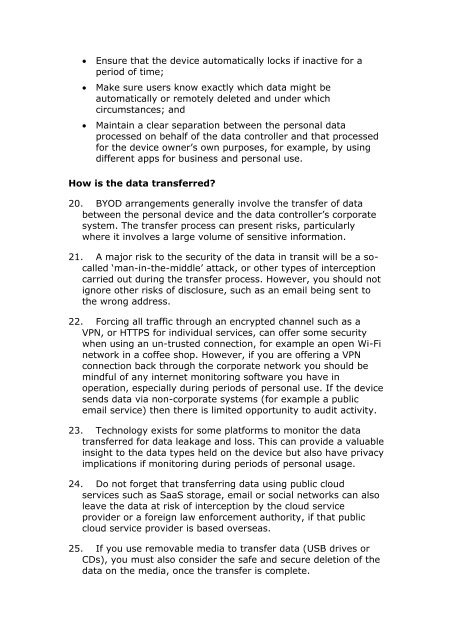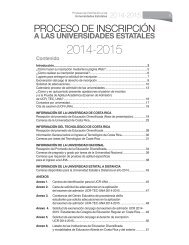Bring your own device (BYOD)
Bring your own device (BYOD)
Bring your own device (BYOD)
You also want an ePaper? Increase the reach of your titles
YUMPU automatically turns print PDFs into web optimized ePapers that Google loves.
Ensure that the <strong>device</strong> automatically locks if inactive for a<br />
period of time;<br />
Make sure users know exactly which data might be<br />
automatically or remotely deleted and under which<br />
circumstances; and<br />
Maintain a clear separation between the personal data<br />
processed on behalf of the data controller and that processed<br />
for the <strong>device</strong> <strong>own</strong>er’s <strong>own</strong> purposes, for example, by using<br />
different apps for business and personal use.<br />
How is the data transferred?<br />
20. <strong>BYOD</strong> arrangements generally involve the transfer of data<br />
between the personal <strong>device</strong> and the data controller’s corporate<br />
system. The transfer process can present risks, particularly<br />
where it involves a large volume of sensitive information.<br />
21. A major risk to the security of the data in transit will be a socalled<br />
‘man-in-the-middle’ attack, or other types of interception<br />
carried out during the transfer process. However, you should not<br />
ignore other risks of disclosure, such as an email being sent to<br />
the wrong address.<br />
22. Forcing all traffic through an encrypted channel such as a<br />
VPN, or HTTPS for individual services, can offer some security<br />
when using an un-trusted connection, for example an open Wi-Fi<br />
network in a coffee shop. However, if you are offering a VPN<br />
connection back through the corporate network you should be<br />
mindful of any internet monitoring software you have in<br />
operation, especially during periods of personal use. If the <strong>device</strong><br />
sends data via non-corporate systems (for example a public<br />
email service) then there is limited opportunity to audit activity.<br />
23. Technology exists for some platforms to monitor the data<br />
transferred for data leakage and loss. This can provide a valuable<br />
insight to the data types held on the <strong>device</strong> but also have privacy<br />
implications if monitoring during periods of personal usage.<br />
24. Do not forget that transferring data using public cloud<br />
services such as SaaS storage, email or social networks can also<br />
leave the data at risk of interception by the cloud service<br />
provider or a foreign law enforcement authority, if that public<br />
cloud service provider is based overseas.<br />
25. If you use removable media to transfer data (USB drives or<br />
CDs), you must also consider the safe and secure deletion of the<br />
data on the media, once the transfer is complete.



